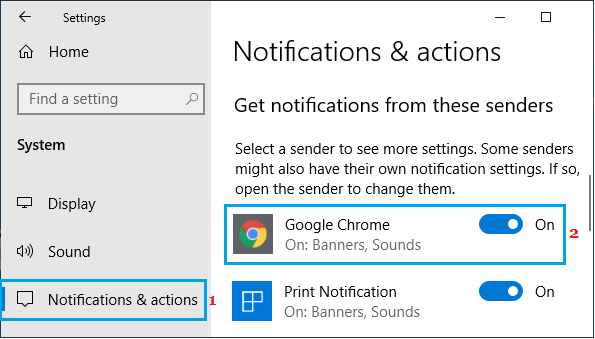

- #TURN ON NOTIFICATIONS FOR GOOGLE CHROME ON MAC HOW TO#
- #TURN ON NOTIFICATIONS FOR GOOGLE CHROME ON MAC WINDOWS 10#
When they are allowed to send notification from your Chrome browser, these sites will gradually prompt mostly ads related notifications on your Windows 10 desktop. Some sites like also forces some advertisements notifications pop-ups through Chrome on Windows 10.

Imagine you are a part of a Facebook Messenger group and the group members are very active in the chat, you would probably get non-stop pop up notifications from Chrome whenever someone chat in the group. If you are logged into your Facebook account on Chrome, whenever there is a notification or new message in Facebook Messenger, Chrome will send you a notification pop up via Action Center on Windows 10 desktop. The most common notifications from Google Chrome are the notifications prompted by Facebook. It can sometimes force minimize your app or game while you are at it. Notification is a useful feature in Windows 10 but it can be annoying when the notifications keep popping up too frequently. Why Disable Chrome Notifications on Windows 10?
#TURN ON NOTIFICATIONS FOR GOOGLE CHROME ON MAC HOW TO#
Type the correct URL into the textbox under Site in the Add a site window.If you are bothered with annoying desktop notifications popped by Chrome such as Facebook notifications or advertisements from random sites, here’s how to turn off Google Chrome notifications on Windows 10 from sites of your choice. Open Chrome -> click the three vertical dots button -> click Site Settings -> select Notifications. Here’s how to allow notifications from specific sites: If you want to block more other sites, please repeat step 6 ~ 9.Ĭan you add an exception if you have blocked notifications from all sites in Chrome? Yes, you can. Please type the correct URL of the site you want to block (you can also copy & paste it to the context menu). Click on the Add button on the right side. Select Notifications under Permissions. Click Site Settings under Privacy and security. Click the three vertical dots button at top right. Google Chrome settings can help you allow or block notifications from one or more sites. How to disable notifications Chrome for specific sites? This is how to remove Chrome notifications from all sites.Ĭan you stop Chrome notifications or remove Chrome notifications from a specific site? Toggle the switch of Sites can ask to send notifications to off. Click Notifications (it's configured to Ask before sending by default). Click Site Settings (it’s the last option of this section). Scroll down to find the Privacy and security section.(You can also click Privacy and security from the left sidebar to go there directly.). 
(You can also type chrome://settings into the address bar and press Enter.)
Select Settings from the drop-down menu. Click on the three vertical dots button in the upper right corner to bring up settings menu. How do I turn off Chrome notifications on Windows 10? MiniTool Solution offers many other Windows 10 tips & tricks for you. Steps of how to turn off Google Chrome notifications Windows 10 and how to disable notifications from apps & other senders will be covered. In this part, I’ll show you how to turn off notifications in Chrome completely or partially. How Do You Stop Auto Refresh In Chrome & Other Browsers? How to Turn off Notifications in Chrome 
You can make Chrome work just how you like it! What if you don't want to see Chrome spam notifications or other notifications anymore? You can go to disable Chrome notifications manually. If you allow it, messages about new changes and push notification will be sent to you by the owner/developer. In Google Chrome, you’ll be asked by default to allow or block the notification request sent by a website, app, or extension. If you don’t want to receive notifications from Google Chrome anymore, you can follow the methods mentioned below to turn them off. Generally, you can decide whether to allow or disallow a page/site to send & show notifications in your browser. Notification is very useful when you need to know what's going on exactly in a certain application, site, or system.








 0 kommentar(er)
0 kommentar(er)
